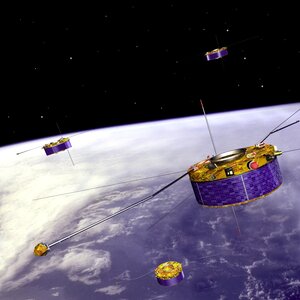Controllers reposition Cluster, creating first-ever multiscale mission
Cluster's four spacecraft are being separated to 10 000 km from each other in one of the most complex manoeuvres ever conducted by ESA controllers. In the new formation, Cluster becomes the first-ever multiscale mission and will continue gathering spectacular magnetosphere data for 4 more years.
The repositioning of Cluster's four satellites started on 26 May and ran until today, just 2 days before Cluster's 5th anniversary.
Mission controllers at ESA's Space Operations Centre (ESOC) have been working midnight and dawn shifts to plan and upload flight commands during specific time slots, which can occur anytime based on ground station availability and the position of the spacecraft in their orbits.
The four craft are moving from approximately 1 000 km to 10 000 km apart.
Increasing separation increases science returns – and reduces dangers of solar storms

The aim of the Cluster mission is to study small-scale structures of the magnetosphere and its environment in three dimensions. To achieve this, Cluster comprises four identical spacecraft moving in a tetrahedral configuration. They orbit in a highly elliptical polar orbit, between 19 000 to 119 000 km, in a 57-hour period.
The knowledge gained has direct application to understanding how the Sun's solar wind and radiation affects the Earth. Solar bursts, or so-called “solar storms”, can disrupt terrestrial communication networks, power grids and data lines. Also, these storms can seriously harm satellites in various space near-earth or distant orbits.
In the new, expanded formation, Cluster will be better able to gather additional data on magnetosphere processes, which happen on a larger scale. "By changing the distance, we are basically changing the 'magnification' of the Cluster 'microscope'," says Juergen Volpp, Spacecraft Operations Manager for the mission.
Controllers meet to map out flight plans

During the manoeuvre period, Volpp conducted regular team meetings with flight control staff to confirm each stage of the manoeuvre schedule. Individual flight controllers were assigned to specific time slots of manoeuvre activity, each slot comprising several hours during which sequential commands must be uploaded and executed by each craft.
"Flight controllers get the manoeuvre commands from the Flight Dynamics team, then they must check that the spacecraft is correctly configured for the manoeuvre and upload the commands; some commands are executed in real time. Then, we monitor the execution to make sure everything is nominal," says Volpp.
There are two main types of orbital manoeuvres: using thrusters firing parallel to the spin axis (axial), or firing at roughly 90 degrees to the spin axis (radial). With the radial manoeuvres, "You have to use two thrusters, one on each side of the spacecraft," says Volpp. "If there is an imbalance in the firing of the two thrusters, you might turn the craft in the completely wrong direction. This is considered critical." Thrusters are small rocket motors on board the craft that produce 10 Newtons of force.
He says that such critical movements are made simpler by splitting one big manoeuvre into several smaller ones, so that a 6-hour thruster burn is actually done in three 2-hour burns, with engineers checking the results of each step before starting the next. "Then, we can intervene if something goes wrong," says Volpp.
The flight control team is looking forward to a period of relatively calm routine operations once the last manoeuvre has been fired on 14 July. But it won't last long.
"After July, we won't have such a heavy workload, says Volpp. But then we have to get ready for the eclipses that will occur in September."
Cluster Facts:
Spacecraft Diameter: 2.9 m
Height: 1.3 m
Mass: 1200 kg
(of which) Propellant: 650 kg
(of which) Scientific payload: 71 kg
Solar array power: 224 W
Spin rate: 15 rpm
Mission duration: 9 years
Flight operations: ESOC, Germany.
Science operations: ESAC, Spain.















 Germany
Germany
 Austria
Austria
 Belgium
Belgium
 Denmark
Denmark
 Spain
Spain
 Estonia
Estonia
 Finland
Finland
 France
France
 Greece
Greece
 Hungary
Hungary
 Ireland
Ireland
 Italy
Italy
 Luxembourg
Luxembourg
 Norway
Norway
 The Netherlands
The Netherlands
 Poland
Poland
 Portugal
Portugal
 Czechia
Czechia
 Romania
Romania
 United Kingdom
United Kingdom
 Slovenia
Slovenia
 Sweden
Sweden
 Switzerland
Switzerland



























